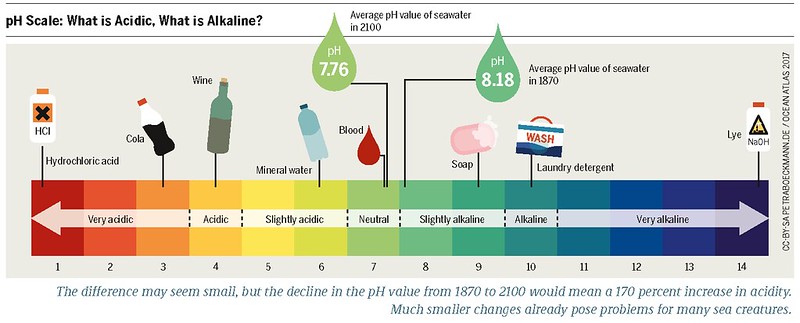When sodium hydroxide (NaOH) is added to water, it dissociates into sodium ions (Na+) and hydroxide ions (OH-), leading to a significant increase in the pH of the solution. Understanding the changes in pH and the factors that influence it is crucial for various applications, such as water treatment, pH adjustment, and industrial processes.
Understanding the pH Scale
The pH scale is a measure of the acidity or basicity of a solution, ranging from 0 to 14. A pH of 7 is considered neutral, values below 7 indicate acidity, and values above 7 indicate basicity. The pH is calculated as the negative logarithm of the hydrogen ion (H+) concentration in the solution.
The Effect of Adding NaOH to Water
When NaOH is added to water, the following reaction occurs:
NaOH → Na+ + OH-
The dissociation of NaOH results in a high concentration of hydroxide ions (OH-) in the solution. These hydroxide ions then react with the hydrogen ions (H+) present in the water, forming water molecules:
OH- + H+ → H2O
This reaction reduces the concentration of H+ ions in the solution, leading to an increase in the pH. The magnitude of the pH change depends on the initial pH of the water and the amount of NaOH added.
Calculating the pH Change
To calculate the pH change after adding NaOH to water, you can use the following formula:
pH = -log[H+]
Where [H+] is the concentration of hydrogen ions in the solution.
For example, let’s say you have a 100 mL solution of water with a pH of 6.0. If you add 10 mL of 0.1 M NaOH, the new pH can be calculated as follows:
-
Calculate the initial H+ concentration:
[H+] = 10^-pH = 10^-6.0 = 1.0 × 10^-6 M -
Calculate the amount of OH- added:
Amount of OH- = 10 mL × 0.1 M = 1.0 × 10^-3 mol -
Calculate the new H+ concentration after the reaction:
H+ + OH- → H2O
[H+] = Kw / [OH-] = (1.0 × 10^-14) / (1.0 × 10^-3) = 1.0 × 10^-11 M -
Calculate the new pH:
pH = -log[H+] = -log(1.0 × 10^-11) = 11.0
In this example, the addition of 10 mL of 0.1 M NaOH to 100 mL of water with an initial pH of 6.0 resulted in a new pH of 11.0, a significant increase in basicity.
Factors Affecting the pH Change
Several factors can influence the pH change when adding NaOH to water:
-
Initial pH: The initial pH of the water affects the magnitude of the pH change. Solutions with a lower initial pH will experience a more significant increase in pH when NaOH is added.
-
Concentration of NaOH: The concentration of the NaOH solution added to the water directly affects the pH change. Higher concentrations of NaOH will result in a more dramatic increase in pH.
-
Volume of NaOH added: The volume of NaOH added to the water also plays a role in the pH change. Larger volumes of NaOH will lead to a more substantial increase in pH.
-
Presence of other substances: The presence of other substances, such as acids or buffers, in the water can affect the pH change. These substances can react with the added NaOH, altering the final pH.
Practical Applications
The ability to control and adjust the pH of water is crucial in various applications, including:
-
Water treatment: Adjusting the pH of water is essential in water treatment processes, such as coagulation, disinfection, and softening, to ensure the water is safe and suitable for its intended use.
-
Industrial processes: Many industrial processes, such as chemical manufacturing, metal processing, and wastewater treatment, require precise pH control to optimize efficiency and comply with environmental regulations.
-
Environmental monitoring: Monitoring the pH of water bodies, such as rivers, lakes, and oceans, is important for assessing the health of aquatic ecosystems and detecting potential pollution or contamination.
-
Laboratory applications: Precise pH control is crucial in various laboratory experiments and analyses, where the pH of solutions can affect the outcome of the experiment or the accuracy of the results.
In conclusion, understanding the impact of adding NaOH on the pH of water is essential for various applications, from water treatment to industrial processes and environmental monitoring. By applying the principles of pH calculation and considering the factors that influence the pH change, you can effectively manage and control the pH of water to meet your specific needs.
References:
- Chemcollective.org. (n.d.). Buffers 2: Calculating pH Changes. [online] Available at: https://chemcollective.org/activities/tutorials/buffers/buffers2 [Accessed 25 Apr. 2023].
- PhysicsForums.com. (2015). Calculating pH of water after adding HCl and NaOH. [online] Available at: https://www.physicsforums.com/threads/calculating-ph-of-water-after-adding-hcl-and-naoh.777324/ [Accessed 25 Apr. 2023].
- Chemistry Stack Exchange. (2015). How do I calculate how much sodium hydroxide I need to add to get a new pH? [online] Available at: https://chemistry.stackexchange.com/questions/35192/how-do-i-calculate-how-much-sodium-hydroxide-i-need-to-add-to-get-a-new-ph [Accessed 25 Apr. 2023].
- MyTutor.co.uk. (n.d.). Calculate the p H change when water is added to 25.0 mL of 0.100 M NaOH to make a 1.00 L solution. [online] Available at: https://www.mytutor.co.uk/answers/20199/A-Level/Chemistry/Calculate-the-p-H-change-when-water-is-added-to-25-0- [Accessed 25 Apr. 2023].
- YouTube. (2018). Calculating pH after adding NaOH. [online] Available at: https://www.youtube.com/watch?v=GokYvBo5Yuo [Accessed 25 Apr. 2023].

